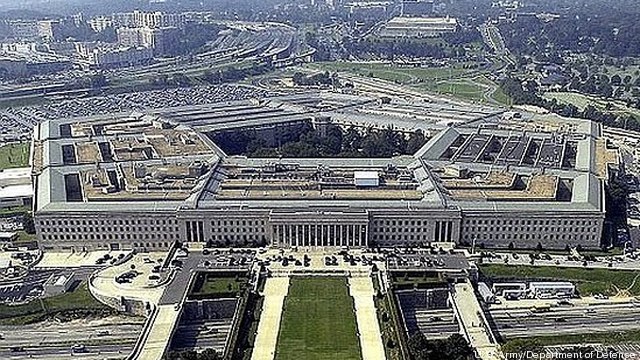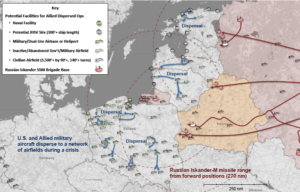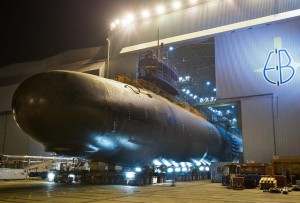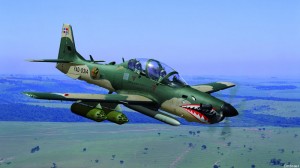New Threats Spark DoD Spending Debate: Thinktanks Ponder $2 Trillion In Options
Posted on

WASHINGTON: If you were hoping, after a bitterly contentious presidential campaign, that at least we’d have consensus on national defense spending…tough luck. Instead, teams from five leading thinktanks — spanning the political spectrum but all using the same budget simulator — came up with a more than $2 trillion spread of options. They debated their plans this morning (moderated by, well, me) at the Newseum.
Do you think we need an urgent buildup to counter Russia, China, and the Islamic State? That’ll be $1.3 trillion extra over the next 10 years, please, conservatives estimate. Would you rather save one trillion instead? Sure, libertarians say, but our allies will have to protect themselves. Or would you rather steer a middle course between the high- and low-cost options? Then get ready for tough choices on what parts of the military to modernize for a major-power war and which parts to keep cheap for day-to-day counterterrorism — what’s called a “high/low mix.”

Defense against a notional Russian missile barrage. (CSBA graphic)
That’s the broad spectrum of alternatives scholars from five thinktanks are presenting today. (It’s important to note that each team represented only the members’ own opinion, not any official position of their parent institution). Despite the diversity of ideas, though, there’s some striking common ground.
To start with, even the most hawkish team didn’t recommend spending as much money on defense as the baseline set back in the presidential budget for 2012, the last before sequestration.
“No one made it to PB12,” said exercise convener Jacob Cohn, from the respected Center for Strategic & Budgetary Assessments, as he overviewed the proposals at a meeting last week. “AEI came closest….”
“We tried,” chuckled Tom Donnelly, head of the team from the conservative American Enterprise Institute, which proposed the $1.3 trillion increase.
“It’s kinda hard, isn’t it?” added Todd Harrison, formerly at CSBA but now leading the team from the centrist Center for Strategic & International Studies. “How were we ever there?”

Graphic courtesy Sen. Dan Sullivan
Rounding out the leaders of the five teams were Cohn’s CSBA colleague Mark Gunzinger, Jerry Hendrix from the Center for a New American Security — which is generally center-left, though Hendrix’s team was largely conservatives — and, a newcomer to these budget drills, Ben Friedman from the libertarian Cato Institute.
It’s Friedman and team Cato that, unsurprisingly, proposed the $1 trillion cut. The US can keep bombing the Islamic State, they argued, but let’s let Europe and Asia bear the burden of their own defense against Russia and China, with the US eventually withdrawing from NATO. “The challenge for US security strategy is to restrain ourselves, to avoid the foolish temptations that power affords,” Friedman told me. “A smaller military will allow fewer foolish wars.”
The other teams, however, all favored some sort of increase. How much, though, ranged all the way from the AEI team’s 20 percent to the CNAS team’s 2 percent. The three Cs — CNAS, CSIS, and CSBA — all clustered in the middle.
While the three Cs proposed some increases to the overall Pentagon budget, they funded many of their new investments by cutting elsewhere. The result was what all three called a “high/low mix.” Much of the military would remain focused on the kind of operations we conduct today: airstrikes against terrorists, advising local allies, patrolling the seas, all without high-end opposition from enemy aircraft, missiles, hacking, or jamming. But a relatively small, extremely expensive elite would be modernized to deter — or, in the nightmare scenario, fight — Russia and/or China.

The Virginia-class attack submarine USS North Dakota.
So what does the high-end force look like? Across all four teams that recommended increasing the budget — the three Cs and AEI — there are strong commonalities:
- More underwater weapons, from expendable robotic mini-subs to manned submarines packed with long-range cruise missiles;
- More stealthy aircraft, especially the in-development B-21 bomber, but also new stealth drones, most expensively a carrier-launched unmanned bomber like the cancelled UCLASS;
- More long-range firepower, including Army missile batteries equipped to strike targets on land and even at sea;
- More missile defense, both traditional hit-to-kill interceptors like the Patriot and new-age solutions like lasers, hypervelocity cannon shells, railguns, and jamming;
- More unmanned systems of all stripes, from underwater to air to ground.
There’s even a common theme to these common themes. They’re all ways to counter adversaries with long-range precision weapons of their own. You can hide in the air (stealth) or under water (subs); you can strike the enemy from so far away he can’t strike back; you can shoot down his missiles before they hit you; or you can be expendable because you’re a robot.
Those are the high-end investments. What about the low end? There was less consensus here, but Army Chief of Staff Mark Milley’s proposal to build Advise & Assist Brigades got traction with a couple of teams. So did buying the Air Force some cheap fighters — even propeller planes — to handle low-threat counterterrorist strikes, taking the burden off high-maintenance, high-priced jets.

Super Tucano attack aircraft
One flagship system that did poorly across the board: aircraft carriers. While iconic embodiments of American power, the carriers cost a lot, and many experts are skeptical how well they’ll survive against an enemy with long-range smart weapons and advanced submarines. Team Cato cut the carrier fleet by four, CNAS and CSIS by one, while CSBA and AEI slightly sped up the procurement of future carriers without affecting the overall fleet size.
That lukewarm take on carriers is something this year’s budget alternatives drill has in common with the inaugural one in 2014. But much else has changed. Back then, the four thinktank teams — CATO had not yet joined — were struggling to come in under the Budget Control Act caps, which have been repeatedly adjusted since. Back then, while the thinktanks worried about China, they could at least count on a peaceful Europe. Three weeks later, Putin’s Little Green Men started moving into Crimea. The best-laid spending plans don’t survive first contact with the enemy.
Subscribe to our newsletter
Promotions, new products and sales. Directly to your inbox.
